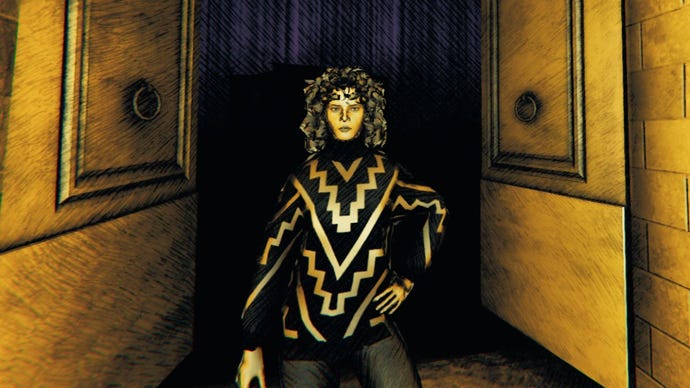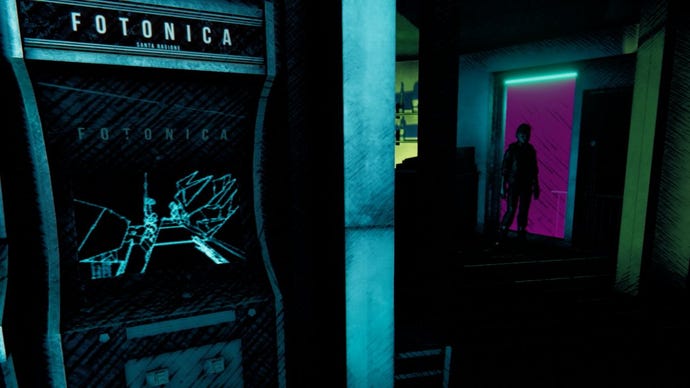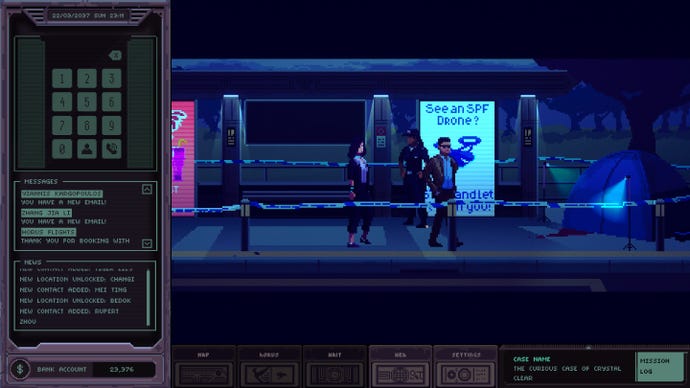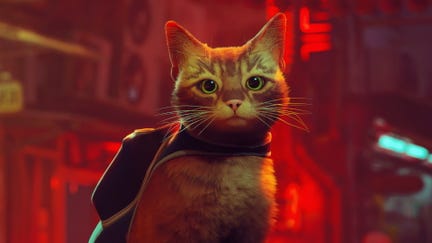Our 24 favourite games of 2022
As voted for by the RPS Treehouse
With all the doors on our RPS Advent Calendar well and truly busted open for 2022 now, we thought it was high time to gather all of our favourite games of the year together in one handy location. If you've been diligently scoffing our Advent treats throughout December, then you'll already know what our game of the year picks are for 2022, but just in case you missed them or want to go through them one final time, we've got 'em all right here for you in our definitive Games Of The Year list. Enjoy!
Below you'll find our top 24 games of 2022, as voted for by the RPS editorial team. This year, we each created a personal top ten list, with our favourite game assigned ten points, our second game nine points and so on. I then totted up all the votes, and the resulting list is what you see before you. Everyone's number one made the cut, and for the first time in at least five years, we actually had a tie-break for our ultimate game of the year - which we solved by a feverish team Slack debate, and casting another final vote in favour of our number one winner.
Of course, there are always loads of games we loved individually this year that didn't quite make it onto our Game Of The Year list, but this year we're starting a new thing to celebrate those honourable mentions - The RPS Selection Box. Every day for the rest of the holidays, we'll be celebrating some more personal favs from the year, so make sure you tuck into those as well as soon as you've finished reading the main list. Without further ado, though, welcome to our 24 Game Of The Year picks for 2022.
24. Warhammer 40K: Chaos Gate - Daemonhunters

Katharine: Warhammer 40K: Chaos Gate - Daemonhunters has been one of the biggest surprises of the year for me. It wasn't on my radar heading into 2022, but the more I heard about it being a kind of angry XCOM in space, the more I thought, "Hold up now, this sounds like 100% my kind of jam". And hot damn, it really was.
Discovering new games that come in and completely sweep you off your feet continues to be one of the best parts of this job, but I was also taken aback by just how much I dug the whole 40K-ness of it all as well. I'm probably about as far as you can get from a diehard Warhammer head, but if someone had told me it was full of sassy tech priests, big chonky metal lads and ridiculously over the top warlords sniping at each other from opposite ends of the universe, I'd have probably thrown myself into its Gothic space fortresses a lot earlier!
Still, the fact that even a Warhammer noob like myself can have a cracking good time with its turn-based strategy battles and not feel like I'm missing out on vital background lore to understand it all is a testament to what Complex Games have achieved here. At its core, this is a tale of good versus evil across the cosmos, of fighting a deadly plague and fragging, foot-stomping and slicing it out of existence. It's intensely satisfying stuff, and easily one of the most enjoyable strategy games I've played all year.


A large part of that is down to its brilliant Warp Surges. On the face of it, Chaos Gate - Daemonhunters incorporates everything you know and love about XCOM, easing you in with all the classic staples like crouching behind cover, setting up overwatch cones and smashing bits of scenery to smithereens with your honking great space marines. But every couple of turns a Warp Surge will chuck a new little wrinkle into the mix, livening up the battlefield with randomised stat buffs that constantly tip the scales in your enemy's favour. These can range from your enemies receiving a temporary armour boost (the turds), your Grey Knights' movement range getting hampered for a spell, or a rift spewing up puddles of acid all over the shop that will burn through your giant shoulder pads like nobody's business if you come into contact with it. Using your Grey Knights special abilities quickens this process as well (thanks, Nurgle), creating a thrilling tension of risk and reward as you contend with ever-changing battle conditions.
That sense of variety is important when there's so much orc skull-splitting to be done in Daemonhunters, but it's also just such good, goddamn fun at the same time. I love the high drama and overblown nature of it all, and it's clear the developers revel in its operatic silliness as well, keeping one eyebrow firmly arched as its cast of Purifiers and Inquisitors proceed to chew the scenery in spectacular fashion. Throw in an overarching strategy layer of fixing up your floating space cathedral and researching extra combat boons while where you're flying around the galaxy tracing the literal seeds of this evil plague, and there's so much to get stuck into with Chaos Gate - Daemonhunters - especially with its first big expansion on the way now, too (which was another most unexpected delight I didn't see coming this year either).
So go on, surprise yourself. Let chaos reign in your strategy games library for a while and see if you don't come back a full, indoctrinated convert to the laws of Nurgle.
23. Who's Lila?

Alice0: Who's Lila? was such a surprise for me. The big, obvious feature of this adventure game is that rather than select dialogue options from a list, you set emotional stances by clicking and dragging your lad's facial features around. That's an eyecatching bit of fun, that. Probably a novelty, yeah? What so delighted me is that not only is Who's Lila? a great detective game full of weird and interesting mysteries to probe, but the face-pulling proves to be both a clever part of the plot and a genuine source of tension.
It's a detective game. A girl from our school is missing and everyone thinks we did something to her. Probably should look into that. Travel about town, search for clues, and chat to people. The game exists in something of a loop, with many endings, but knowledge carrying over between goes, and it'll take many attempts to figure it all out. It's also a metaphysical horror game. I'll not say much about that but I really enjoyed it. Great terrible vibes.

I like the happy accidents of dragging William's face around. You think he'd best say something charming so you shoot for happy, but as the timer ticks down you can't get the eyebrows right and oh god his mouth started to droop and now the game is intepreting it as angry. But sometimes, for example, making someone angry and taking a kicking might lead your investigation in a fruitful direction you hadn't intended.
In all honesty, I suspect most players turned to Google at some point. Things get tricky as the barriers of reality start to bleed, both in the game and on your computer. But it's a wonderful thing, full of mysteries, horrors, and creative thinking as you try to pull them all together.
Rachel: I'm still struggling to understand exactly what happened in Who's Lila? but I'll never forget its creepy face contortion mini-game. I got the heebie-jeebies every single time I fumbled to move young William's face into another contorted mess with only a hint of human emotion. Who's Lila? is initially a tough game to get into at first - I honestly was totally lost when playing the first hour - but its slow burn of a detective tale about a missing teenager is both gripping and dream-like.
Controlling the character's facial expressions in replacement of choosing dialogue options is both incredibly clever and incredibly creepy. Like you're manipulating the fleshy husk of a human being. Playing Who's Lila? feels like you found an old DS cartridge at the bottom of a bargain bin at a cursed Woolworths, and it's nothing like any other game on our calendar this year, that's for sure.
22. Saturnalia

Alice Bee: I think it was reasonably easy to guess that I would get Saturnalia on this list by hook or by crook - or, indeed, by terrifying masked creature. But I promise I will only carry you off to my subterranean nest and cannibalise you in part of an ancient folk ritual as last resort (or if you ask me real pretty, like).
A few years ago it was a fairly common, and not very good joke to post an example of a game breaking or being stupid, captioned "video games are bad, actually lololol", but I'll tell you a secret reader: a few times this year I found myself in a grey-fog-state-of-mind kind of place where I thought that for real. It was during one such period that, splashing about in a sea of boring, I played Saturnalia. It was like an angel throwing me a life jacket and saying "video games are good".

I will own that it's not for everyone, 'cos it's a horror game, and it's a frightening one. At least - and to the extent that different kinds of horror will scare different kinds of people - I think it's very scary. It's set in a fictional Sardinian mining town, almost totally cut off from the rest of the world, and mired in decades-old secrets and traditions. Rather than try to change anything, the locals in Gravoi are content to hold a yearly folk festival which, every so often, is also host to an eldritch monstrosity crawling around the mining tunnels beneath the town and popping up to snatch anyone out on the streets after dark.
You play a group of four outsiders trying to a) survive the night and b) escape, the latter being instrumental in the former, and requiring that you explore Gravoi to find various buildings and tools that will be useful. Exploring is easier said than done, though because there's no HUD map or quest markers. There are in-game map boards to look at every so often, but apart from that you just have to, you know, learn the town. Like real life used to be. Each character has a different set of (very limited) skills, like a polaroid flash camera or a map and compass for traversing the mines. You can also discover a web of stories and secrets wrapped around a cast of largely unseen townsfolk who all manage to seem desperate and/or sad, despite you only experiencing them through letters or photos or scraps of personal ephemera. All the while, the creature can appear to chase you, with your only defense really being to run and hide.

Saturnalia boasts excellent sound design - most especially for the creature itself, which rattles when it approaches and, in some circumstances, gives off an unholy shriek to chill the ol' marrow - and absolutely beautiful visual style. It blooms in unreal neon shades that add colour to the dark, black and white alleyways of Gravoi. During my play through I started to view the monster as just a manifestation of my real enemy, which was the town itself.
If all four of the characters are snatched by the creature, the town rearranges itself into a totally new configuration. It is never not a hostile space to exist in. You only get caught because you get lost, and can't find anywhere to hide. You're only in danger because the locals won't help. They're so resistant to change that people have died, and will continue to. In more ways than one. It's a metaphor, is what I'm saying. And it's bloody good.
21. Strange Horticulture

Alice Bee: I often think that I would like to run a small shop selling a niche of products. Except, I wouldn't want that, because that would involve doing a different kind of tax and paying rent on the premises and ordering stock and etc. and so on. So what I would actually like is to run a shop like Strange Horticulture. It's a place out of time, a retail simulator where what you sell are answers to problems in the form of weird plants. You sit in your shop, and people come as supplicants to an altar and ask you: I need the plant to help me sleep, which is it? I am troubled by visions, so should I take the plant to stop them, or make them stronger? Which of these plants will open a lock?
And you open your big illustrated tome of plants, and you flick to the right page, and you take note of the description. And then you look through the pots on your shelves, and you find what your customers are looking for. There's a deeper mystery, too, but what I most loved about Strange Horticulture was that tactility. As I moved the plant pots around, as I read about how some leaves felt sharp, or others smelled of citrus, I was transported! I felt I really was pulling open the secret drawer in my desk and poring over the map of the area, that I really was putting new pages in my instructional tome, and carefully writing out my labels for the plants. What a lovely, and slightly sinister shopkeeper to be.

Rebecca: Did you know that in Strange Horticulture, you can prevent Hellebore the cat from becoming startled by the ringing of the shop bell? What you need to do is pet him right before you ding, launching him into his getting-scritches animation and therefore overriding his scared animation. I know this because my partner played Strange Horticulture before I did, and was so adamant about not scaring Hellebore with the bell that I actually went into the game believing there was some sort of hidden cat stress metre I needed to manage. Then I remembered that my partner is just a big softie when it comes to cats. I still did it every time, though, because you should be nice to Hellebore.

Strange Horticulture wasn't a hard sell for me: it's an indie game about running a little plant shop in the company of a friendly black cat, and to be honest, I think about chucking in this job to pursue that exact dream at least once a week. What's more, I have an enduring interest in video games set in the UK that aren't based around London. To the best of my recollection I've only visited Windermere once in my life, but it was one of those random nice days out that for some reason becomes a core childhood memory, so I was out-of-proportion excited to see the Lake District as the setting of a game.
There's also a certain fascination I have with any game that puts you in the shoes of a character who'd traditionally be an NPC. I'm a sucker for the sub-genre where you run a blacksmith's shop or a market stall of miscellany, providing the heroes with the key item at the exact right moment, but for you it's just an ordinary day. In Strange Horticulture, the leading figures in an intricate occult mystery pass through your shop on a daily basis, but you're just mainly puttering about the place thinking about your plants. It's a delightful side-angle to see this dark fairytale from, with the added bonus that it ups the creepiness factor significantly.
Now remember: it's scritches for Hellebore, then ring the bell.
20. Chinatown Detective Agency

CJ: It's a the rare game that tasks you with periodically putting it aside to stretch your book learnin' and search up some real-life information. That's exactly what Chinatown Detective Agency does, though, posing stumpers such as identifying stamps from around the globe, or figuring out a message using number sequences and library books. It tickles your little grey cells – je suis désolé, Monsieur Poirot – in a way that other games don't or can't, connecting the near future mysteries that cross the path of titular Chinatown detective Amira Dharma to our own existence. In case you can't tell, I really like it.
Point and click adventures from back when I were a lad often used to veer into silliness and baffling obscurity with their puzzles. I still remember spending weeks resisting the urge to check a cover-mounted tips book for any bloody clue at all on how to properly muck about with some crab fishing pots in Indiana Jones And The Fate Of Atlantis. Chinatown Detective Agency knows it exists in the glistening, connected future, and just lets you Google stuff. Thing is, this feels like genuine research a lot of the time.

Some of the best games I've ever had the pleasure of being sufficiently brain-boggled by have demanded the need for a pen and paper to scribble copious musings on. CDA – can I call you CDA? – slots neatly in amongst them, like a Wordle on the third go. Amira's a fairly likeable blank slate to beam your self-perceptions onto, which helps drag you into the seedy cyberpunk world. It feels like glimpsing a possible future. I don't want to spoil any of the cases, because you should at least give the game a go sometime, but they touch on issues we all already face such as energy poverty, hugely corrupt elites, and even the odd drone assassination.
What a lovely, heartwarming recommendation at Christmastime, eh? Set all the weighty global shenanigans aside though, because I think my favourite part of Chinatown Detective Agency is managing the business. You have to select cases for Amira, weighing up the powerful people you might piss off against any financial reward if you solve the case. You have constraints that are recognisable and uncomfortable enough to make solving cases seem appropriately urgent, such as paying the bills. On the flip side, you do get to travel and see the world while you're working.
The easiest way to summarise CDA is Carmen Sandiego 2037, but that obscures its depths. Looking for something to occupy your noggin? Or even a game to rope family members into helping you with, while you're all high on roast turkey over the holidays? I know a little business in Singapore that'd be glad to have you aboard. Just keep your nose clean.

Alice Bee: I want to add a couple of points to everything CJ has raised here. The first is that Chinatown Detective agency looks and sounds fantastic. A full voice cast is often a luxury in point and click mysteries, but the cast of CDA do a wonderful job. The different pixelated backdrops, meanwhile, are gorgeous, and cities look different during day or night. It's a detail I appreciated.
The second point is that, AI learning being what it is, when you play the game now you have to add -"Chinatown Detective Agency" to the end of your Google search, or else you'll just get guides and exact answers.









